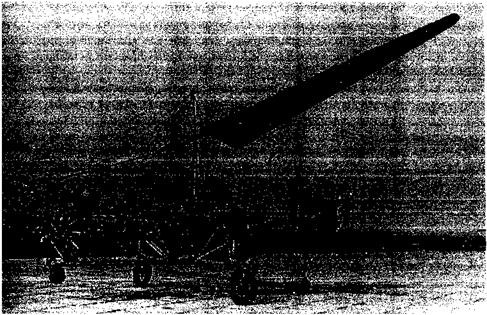. The First Hoverers
During 1919-1926 Louis Brennan worked on a helicopter concept with a large single two-bladed rotor of 60 ft (18.3 m) in diameter. Graham (1973), Everett-Heath (1986), and Fay (1987) give good accounts of Brennan’s work. Brennan, an affluent scientist who had previously invented the modem torpedo and a monorail system, had a different approach to solving the problem of torque reaction by powering the rotor with propellers mounted on the blades (Fig. 1.13). These were driven by drive shafts running along the blades to gearboxes. Control was achieved by the use of “ailerons” inboard of the propellers, which were actuated by means of compressed air. The machine was powered by a 230-hp Bentley rotary. While Brennan’s work was initially carried out with considerable secrecy, in 1921 the machine was officially being tested at the Royal Aircraft Establishment at Farnborough. In 1922, the machine flew successfully inside a hangar, apparently at one point carrying four “passengers.” Further flights outdoors were undertaken through 1926, where the machine made flights at low altitude and was able to fly about 600 ft (182 m) forward. Lack of stability and control caused the machine to crash on its seventh flight, even with the addition of stability enhancing devices. By 1928 the Air Ministry ordered a concept called a “Helicogyre” designed by the Italian Vittorio Isacco to be built in Britain. The machine made only a few tethered flights. British interest in helicopters quickly faded because of concurrent interest in the autogiro (see Section 1.7).
During the early 1920s, Raul Pescara, an Argentinean living and working in Spain and France, was building and attempting to fly a coaxial helicopter with biplane-type rotor blades (Fig. 1.14). On his first machine, each rotor had six sets of blades that were mounted rigidly to the rotor shaft and this was later decreased to four sets per rotor. As described by Boulet (1984), Pescara’s work focused on the need for proper control of the machine, which
 |
was achieved through cyclic pitch changes that could be obtained by warping (twisting) the blades periodically as they rotated. This was one of the first successful applications of a cyclic pitch concept to a helicopter. Yaw was controlled by differential collective pitch between the two rotors. Early versions of Pescara’s machine were underpowered, which
|
Figure 1.15 Between 1924 and 1930, A. G. von Baumhaeur made attempts to fly a single main rotor helicopter with a separately powered tail rotor. (Courtesy NASM, Smithsonian Institution, SI Neg. No. 77-721.) |
may not be surprising considering the large number of blades and high profile drag of the bracing wires of his rotor, and the aircraft did not fly. With a later version of his helicopter using a more powerful engine, some successful flights were accomplished. This attempt reflects much early thinking on helicopters, where more powerful (and heavier) engines were often used rather than trying to make the rotors more efficient. However, as might be expected, these flights were not very successful and with the limited control available they resulted in damage or serious crashes followed by long periods of rebuilding. By 1925 Pescara had finally abandoned his helicopter projects.
Between 1924 and 1930, a Dutchman named A. G. von Baumhaeur designed and built one of the first single rotor helicopters with a tail rotor to counteract torque reaction. Boulet (1984) gives a good description of the machine. Figure 1.15 shows that the fuselage of the von Baumhaeur machine consisted essentially of a tubular truss, with an engine mounted on one end. The other end carried a smaller engine, which turned a conventional propeller to provide a side force and so countering the main rotor torque reaction. The main rotor had two blades, which were restrained by cables so that the blades flapped about a hinge like a seesaw or teeter board. Control was achieved by a swashplate mechanism, which was another early application of this device that was later to provide one standard means of providing blade feathering for collective and cyclic pitch control on the modem helicopter.[6] Unfortunately, von Baumhaeur did not interconnect the main and tail rotors with a transmission, so this caused considerable difficulties in balancing torque and giving proper directional control. Nevertheless, the machine was reported to have made numerous short, hovering flights. It was, however, considerably less capable than the Pescara machine.
In the late 1920s, the Austrians Raoul Hafner and Bruno Nagler designed and built a single-seat helicopter – see Everett-Heath (1986) and Fay (1987). The two variants, the R. I and R. II, used a single rotor configuration with a pair of fixed wings located in the rotor downwash to provide anti-torque. The flights were mostly unsuccessful despite some brief tethered hovering flights of up to a minute. For rotor control, Hafner’s machine in notable in that it used a continuously variable blade pitch change mechanism using a large diameter bearing or swashplate – see Nagler & Hafner (1932). In 1932 Hafner emigrated to Britain, where he and Juan de la Cierva independently continued work on blade articulation for autogiros and later for helicopters. A later variant of the Hafner R. II used flapping blades, which gave’the machine improved control capability. In 1938 Nagler joined Franz Rolz in Germany to form the Nagler Rolz Flugzeugbau, who continued to develop small lightweight helicopter concepts. Hafner was to stay in Britain and became a prolific and forward-thinking rotorcraft designer for Bristol Helicopters [see Hafner (1954)] and later at Westland Helicopters.












